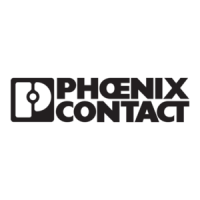
Do you have a question about the Phoenix Contact UM EN FL WLAN EPA and is the answer not in the manual?
| Power Supply | 24 V DC |
|---|---|
| Standards | IEEE 802.11a/b/g/n |
| Technology | WLAN |
| Frequency | 2.4 GHz / 5 GHz |
| Data Rate | Up to 300 Mbps |
| Housing Material | Plastic |
| Mounting Type | DIN rail mounting |
| Interface | Ethernet (RJ45) |
| Security | WPA, WPA2 |
| Operating Temperature | -20°C to 60°C |
Defines the target audience for the manual.
Explains safety symbols and signal words (DANGER, WARNING, CAUTION, NOTE, INFO).
Provides contact information and website for support.
Describes the WLAN Ethernet port adapter and its capabilities.
Explains the benefits and applications of Factoryline WLAN.
Lists the available device versions and their order numbers.
Details country approvals and compliance with R&TTE directive.
Describes firmware versions and their capabilities.
Provides FCC compliance statements and warnings.
Instructions for mounting the device on a level surface.
Provides dimensions and drill hole pattern for mounting.
Instructions for mounting the device on a 35 mm DIN rail.
Instructions for mounting the device to a wall or mast.
Explains the use of fixing holes for mounting.
Details internal and external antenna options.
Describes how to connect the power supply.
Details the LAN interface and its specifications.
Details the electrical connections via M12 sockets.
Explains the device LEDs for status and diagnostic information.
Outlines various methods for configuring the device.
Explains how to configure the device using the MODE button.
Provides examples for device configuration.
Details the device's default settings upon delivery or reset.
Describes how to access and use the web-based management interface.
Step-by-step guide to connect the EPA to a WLAN network.
Explains how to use AT commands for configuration and monitoring.
Details the process for updating the device firmware via TFTP.
Describes how to use SSC scripts for automated configuration.
Explains the basics and purpose of SNMP.
Lists the MIBs supported by the device.
Discusses how radio waves propagate and factors affecting them.
Explains outdoor radio wave propagation and the Fresnel zone.
Details conditions for planning wireless paths, including antenna height.
Lists attenuation values for wireless signals at different distances.
Describes radio wave propagation within industrial halls.
Explains different operating modes for the LAN interface.
Discusses PROFINET/PROFIsafe requirements for wireless transmission.
Provides general specifications like dimensions, temperature, and weight.
Details interface specifications, including WLAN and Ethernet.
Lists results of mechanical tests like shock and vibration resistance.
Lists regulatory approvals like FCC and EMC directives.
Provides product and accessory ordering information.
Contains the EC declaration of conformity for the product.